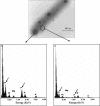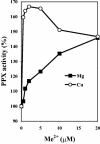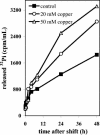Copper ions stimulate polyphosphate degradation and phosphate efflux in Acidithiobacillus ferrooxidans
- PMID: 15345397
- PMCID: PMC520870
- DOI: 10.1128/AEM.70.9.5177-5182.2004
Copper ions stimulate polyphosphate degradation and phosphate efflux in Acidithiobacillus ferrooxidans
Abstract
For some bacteria and algae, it has been proposed that inorganic polyphosphates and transport of metal-phosphate complexes could participate in heavy metal tolerance. To test for this possibility in Acidithiobacillus ferrooxidans, a microorganism with a high level of resistance to heavy metals, the polyphosphate levels were determined when the bacterium was grown in or shifted to the presence of a high copper concentration (100 mM). Under these conditions, cells showed a rapid decrease in polyphosphate levels with a concomitant increase in exopolyphosphatase activity and a stimulation of phosphate efflux. Copper in the range of 1 to 2 microM greatly stimulated exopolyphosphatase activity in cell extracts from A. ferrooxidans. The same was seen to a lesser extent with cadmium and zinc. Bioinformatic analysis of the available A. ferrooxidans ATCC 23270 genomic sequence did not show a putative pit gene for phosphate efflux but rather an open reading frame similar in primary and secondary structure to that of the Saccharomyces cerevisiae phosphate transporter that is functional at acidic pH (Pho84). Our results support a model for metal detoxification in which heavy metals stimulate polyphosphate hydrolysis and the metal-phosphate complexes formed are transported out of the cell as part of a possibly functional heavy metal tolerance mechanism in A. ferrooxidans.
Figures





References
-
- Barreto, M., R. Quatrini, S. Bueno, C. Arriagada, J. Valdes, S. Silver, E. Jedlicki, and D. S. Holmes. 2003. Aspects of the predicted physiology of Acidithiobacillus ferrooxidans deduced from analysis of its partial genome sequence. Hydrometallurgy 71:97-105.
-
- Boyer, A., J-P. Magnin, and P. Ozil. 1998. Copper ion removal by Thiobacillus ferrooxidans biomass. Biotechnol. Lett. 20:187-190.
Publication types
MeSH terms
Substances
LinkOut - more resources
Full Text Sources
Other Literature Sources
Molecular Biology Databases

